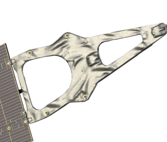 Artist's rendering of the Juno spacecraft | |||||||||||||||||||
| Names | New Frontiers 2 | ||||||||||||||||||
|---|---|---|---|---|---|---|---|---|---|---|---|---|---|---|---|---|---|---|---|
| Mission type | Jupiter orbiter | ||||||||||||||||||
| Operator | NASA / Jet Propulsion Laboratory | ||||||||||||||||||
| COSPAR ID | 2011-040A | ||||||||||||||||||
| SATCAT no. | 37773 | ||||||||||||||||||
| Website | |||||||||||||||||||
| Mission duration |
| ||||||||||||||||||
| Spacecraft properties | |||||||||||||||||||
| Manufacturer | Lockheed Martin Space | ||||||||||||||||||
| Launch mass | 3,625 kg (7,992 lb) [1] | ||||||||||||||||||
| Dry mass | 1,593 kg (3,512 lb) [2] | ||||||||||||||||||
| Dimensions | 20.1 × 4.6 m (66 × 15 ft) [2] | ||||||||||||||||||
| Power | 14 kW at Earth, [2] 435 W at Jupiter [1] 2 × 60-ampere hour, 28 Volt lithium-ion batteries [3] | ||||||||||||||||||
| Start of mission | |||||||||||||||||||
| Launch date | August 5, 2011, 16:25:00 UTC | ||||||||||||||||||
| Rocket | Atlas V 551 (AV-029) | ||||||||||||||||||
| Launch site | Cape Canaveral, SLC-41 | ||||||||||||||||||
| Contractor | United Launch Alliance | ||||||||||||||||||
| Flyby of Earth | |||||||||||||||||||
| Closest approach | October 9, 2013 | ||||||||||||||||||
| Distance | 559 km (347 mi) | ||||||||||||||||||
| Jupiter orbiter | |||||||||||||||||||
| Orbital insertion | July 5,2016, [4] 9 years,5 months,9 days ago | ||||||||||||||||||
| Orbits | 76 (planned) [5] [6] | ||||||||||||||||||
| Orbital parameters | |||||||||||||||||||
| Perijove altitude | 4,200 km (2,600 mi) altitude 75,600 km (47,000 mi) radius | ||||||||||||||||||
| Apojove altitude | 8.1×106 km (5.0×106 mi) | ||||||||||||||||||
| Inclination | 90°(polar orbit) | ||||||||||||||||||
| |||||||||||||||||||
 Juno mission patch | |||||||||||||||||||

Juno is a NASA space probe orbiting the planet Jupiter. Built by Lockheed Martin and operated by NASA's Jet Propulsion Laboratory,the spacecraft was launched from Cape Canaveral Air Force Station on August 5,2011 UTC,as part of the New Frontiers program. [7] Juno entered a polar orbit of Jupiter on July 5,2016,UTC, [5] [8] to begin a scientific investigation of the planet. [9] After completing its mission,Juno was originally planned to be intentionally deorbited into Jupiter's atmosphere, [9] but has since been approved to continue orbiting until contact is lost with the spacecraft, [10] but it is scheduled to be shut down per the FY2026 budget proposed by the second Donald Trump administration. [11] However,if Juno mission receives a third mission extension,it will continue to explore Jupiter for another three years to study Jovian rings and inner moons area which is not well explored; [12] this phase will also include close flybys of the moons Thebe,Amalthea,Adrastea,and Metis. [13]
Contents
- Naming
- Overview
- Flight trajectory
- Orbital operations
- Team
- Cost
- Scientific objectives
- Scientific instruments
- Microwave radiometer (MWR)
- Jovian Infrared Auroral Mapper (JIRAM)
- Magnetometer (MAG)
- Gravity Science (GS)
- Jovian Auroral Distributions Experiment (JADE)
- Jovian Energetic Particle Detector Instrument (JEDI)
- Radio and Plasma Wave Sensor (Waves)
- Ultraviolet Spectrograph (UVS)
- JunoCam (JCM)
- Operational components
- Satellite bus
- Solar panels
- Telecommunications
- Propulsion
- Galileo plaque and minifigures
- Scientific results
- Timeline
- Gallery
- Jupiter
- Moons
- See also
- Notes
- References
- External links
Juno's mission is to measure Jupiter's composition,gravitational field,magnetic field,and polar magnetosphere. It also searches for clues about how the planet formed,including whether it has a rocky core,the amount of water present within the deep atmosphere,mass distribution,and its deep winds,which can reach speeds up to 620 km/h (390 mph). [14]
Juno is the second spacecraft to orbit Jupiter,after the RTG-powered Galileo orbiter,which orbited from 1995 to 2003. Unlike all earlier spacecraft sent to the outer Solar System and beyond—which used radioisotope thermoelectric generators for power—Juno is powered by solar panels,more commonly used by satellites orbiting Earth and working in the inner Solar System. [9] Accordingly,Juno required the three largest solar panel wings ever deployed on a planetary probe (at the time of launching). These play an integral role in stabilizing the spacecraft as well as generating power. [15]
As of December 2025,Juno remains operational and is in contact with Earth through the NASA Deep Space Network. [16] A next extended mission proposal is currently being reviewed. [17]


















































